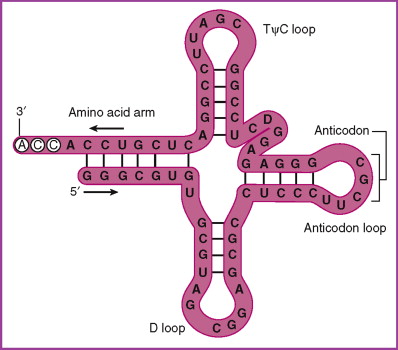
Transfer RNAs Genes
 المؤلف:
Genetics Home Reference
المؤلف:
Genetics Home Reference
 المصدر:
Help Me Understand Genetics
المصدر:
Help Me Understand Genetics
 الجزء والصفحة:
الجزء والصفحة:
 17-10-2020
17-10-2020
 2406
2406
Transfer RNAs Genes
Genes in the transfer RNAs gene group provide instructions for making molecules called transfer RNAs (tRNAs). Transfer RNAs are a particular type of RNA, which is a chemical cousin of DNA. These molecules help assemble protein building blocks (amino acids) into functioning proteins. Each tRNA attaches to a particular amino acid. During protein assembly, the tRNA recognizes a specific three-letter sequence (a codon) in the genetic blueprint for making proteins and inserts the amino acid into the appropriate location in the growing protein.
There are two classes of tRNA: cytoplasmic and mitochondrial. Cytoplasmic tRNAs are found in the fluid inside cells (the cytoplasm). These tRNAs help produce proteins from genes located in the DNA in the nucleus of the cell (nuclear DNA). Although most DNA is nuclear, cellular structures called mitochondria have a small amount of their own DNA, called mitochondrial DNA. Proteins produced from genes located in mitochondrial DNA are assembled by mitochondrial tRNAs.
Mutations in transfer RNA genes reduce the ability of the tRNA to add amino acids to proteins, slowing protein production. Mutations that affect mitochondrial tRNAs impair the ability of mitochondria to provide energy for cells or to control blood sugar levels. These mutations can cause a variety of signs and symptoms, including muscle weakness, seizures, neurological problems, hearing loss, and diabetes. Mutations in genes that provide instructions for cytoplasmic tRNAs do not appear to cause disease.
Examples of genes in this gene group: MT-TE, MT-TH, MT-TK, MT-TL1, MTTS1,MT-TV
The HUGO Gene Nomenclature Committee (HGNC) provides an index of gene groups (https://www.genenames.org/data/genegroup/#!/group/478) and their member genes.

References
McClain WH. Transfer RNA identity. FASEB J. 1993 Jan;7(1):72-8. Review. PubMed: 8422977 (https://www.ncbi.nlm.nih.gov/pubmed/8422977).
Rich A, RajBhandary UL. Transfer RNA: molecular structure, sequence, and properties. Annu Rev Biochem. 1976;45:805-60. Review. PubMed: 60910 (https://www.ncbi.nlm.nih.gov/pubmed/60910).
Suzuki T, Nagao A, Suzuki T. Human mitochondrial tRNAs: biogenesis, function, structural aspects, and diseases. Annu Rev Genet. 2011;45:299-329. Epub 2011 Sep 6. Review. PubMed: 21910628 (https://www.ncbi.nlm.nih.gov/pubmed/21910628).
 الاكثر قراءة في مواضيع عامة في الاحياء الجزيئي
الاكثر قراءة في مواضيع عامة في الاحياء الجزيئي
 اخر الاخبار
اخر الاخبار
اخبار العتبة العباسية المقدسة


